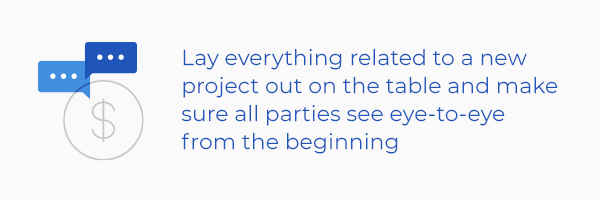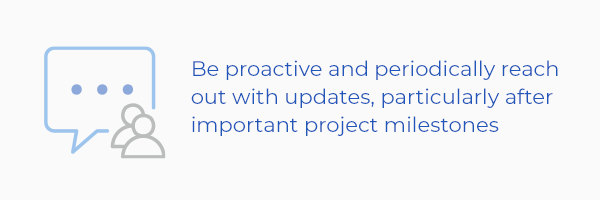Improve Cash Flow with These 3 Communication Skills for Architects

A healthy, reliable cash flow is the cornerstone of financial stability for architects. And with financial stability comes the freedom to explore new strategies and take on more complex projects.
Accordingly, avoiding interruptions to your cash flow is crucial for your long-term success as an architect. What you may not realize, though, is that oftentimes the issues that lead to disruptions to your revenue can be prevented with effective communication.
Read on to learn three of the most important communication skills for architects and why you need to adopt these techniques this year.
Discuss payment expectations during the initial client meeting
 The initial client meeting presents the best opportunity to lay everything related to a new project out on the table and make sure all parties see eye-to-eye from the beginning. And if you have the client complete a pre-qualification questionnaire beforehand, then you’ll already have a good idea of their overall expectations regarding scope, costs, and timelines, which means you can use the first meeting to dig deeper into the nitty gritty details of the project and your process, including how you manage billing and payments.
The initial client meeting presents the best opportunity to lay everything related to a new project out on the table and make sure all parties see eye-to-eye from the beginning. And if you have the client complete a pre-qualification questionnaire beforehand, then you’ll already have a good idea of their overall expectations regarding scope, costs, and timelines, which means you can use the first meeting to dig deeper into the nitty gritty details of the project and your process, including how you manage billing and payments.
As far as your rates and anticipated expenses, it may seem sufficient to have a general discussion about costs and fees as well as basic payment terms (e.g., due on receipt, net 30, net 45) and confirm the client understands how much they will be charged.
The issue is that this approach somewhat oversimplifies the process into simply “architect sends invoice” and “client pays invoice” when, really, it’s considerably more nuanced than that.
Since invoicing and payment processing involve multiple moving parts and since each of those parts can be handled in a myriad of ways, you need to set aside time in the initial client meeting specifically to talk through what the client can expect from you and what you expect from the client in terms of billing and payments.
For example, how will the invoices be sent—electronically, via postal mail, or both? And at what intervals can the client expect to receive invoices? What are the payment methods available to the client? Additionally, are there any notes the client needs you to include on the statement to prevent payment delays, such as a PO number or an additional person’s contact information? What is your policy on late payments? Is there a grace period and what are the penalties?
Broaching the topic of billing and payment expectations can sometimes feel a bit uncomfortable, but having the ability to adeptly lead the conversation is among the most crucial communication skills for architects because it can have a huge impact on the speed and consistency of payments.
Draft more comprehensive client-architect agreements
 Just as important as effective verbal communication is strong written communication. And when it comes to a new project, one of the most critical documents is the client-architect agreement.
Just as important as effective verbal communication is strong written communication. And when it comes to a new project, one of the most critical documents is the client-architect agreement.
According to the AIA, there are four core elements that every contract should contain:
- The client’s goals and objectives for the project
- Descriptions of the architect’s scope of services and deliverables
- A schedule of when services will be completed and deliverables will be provided
- A detailed list of fees and expenses as well as when payments for these are due
However, the AIA points out that these are merely the basics, and that architects who include language that thoroughly addresses potential budget-related complications and explains how those would be handled will be in a much better position to manage issues down the line than architects who leave such matters open to interpretation.
Consequently, knowing how to draft a contract that protects both your and your client’s finances is one of the most essential communication skills for architects.
The AIA recommends clarifying the following in your client-architect agreement:
- Who is responsible for cost-estimating?
- Are you required to design to the client’s budget?
- What happens if your design exceeds the client’s budget?
- How should you proceed if services outside the initial scope are required?
- What steps are taken if the client doesn’t pay the full amount she was invoiced?
You should treat these elements of the agreement as an extension of your conversation from the initial client meeting. None of the items should come as a complete surprise to the client but rather should be approached as simply an elaboration on aspects of the project that had been previously talked about.
It may seem a bit like overkill, but the truth is that failing to address plausible hypotheticals in your client-architect agreement doesn’t make them any less likely to occur. Instead, it just puts you in a position where you’re forced to tackle these challenges without the advantage of having a written contract to back up your decisions. Plus, if the dispute takes weeks or even months to resolve, it could cause a major disruption to your cash flow.
Commit to consistent correspondence throughout the project
 If you kick off each project by first reviewing expectations about billing and payments with your client and follow up with a thorough written client-architect agreement, you can rest assured that you’ve done your due diligence to ensure the engagement starts on the right foot.
If you kick off each project by first reviewing expectations about billing and payments with your client and follow up with a thorough written client-architect agreement, you can rest assured that you’ve done your due diligence to ensure the engagement starts on the right foot.
Then, once the project is successfully underway, if you want to be confident that 1) it will stay on track, and 2) you won’t have to worry about billing issues, you need to practice our third recommended communication skill for architects: regularly connecting with the client.
This means not only being available when the client has questions or concerns but also being proactive and periodically reaching out with updates, particularly after important project milestones, such as when all project stakeholders have signed off on a design.
It’s also a good idea to send follow up emails after each phone call and meeting (both scheduled and ad hoc) with a short summary of the conversation, including who attended, what was discussed, and any action items. Again, this helps keep everyone on the same page, ensures that what you said and what the client heard are the same thing, and decreases the risk of anyone making potentially costly assumptions.
Along with prioritizing transparency with respect to news and status updates, you should also emphasize it in the context of invoices and any communication about payments.
Start by making sure your billing statements are adequately descriptive and easy to understand. You certainly don’t need to go into the minutiae of the work you completed, but invoices with line items that clearly indicate what the client is being charged for are much more likely to be paid without hesitation than statements with undecipherable acronyms and needlessly vague descriptions.
In situations where the total amount due is unusually higher or lower than previous months, include a brief note explaining why—e.g., changes at the project site led to a temporary pause in design work or special circumstances required the hiring of an outside consultant.
The goal here is to actively reduce opportunities for miscommunication or misunderstandings about the project that can affect the client’s willingness to pay.
These communication skills for architects help mitigate the more intangible roadblocks to payments (like misconceptions and misaligned expectations) that can affect your cash flow. To minimize the risk of late or non-payments even more, use an online payment solution that makes it easy for clients to pay invoices from anywhere—like ClientPay.